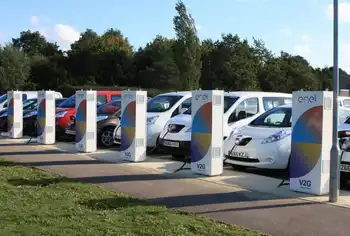The time is right for Zenn cars
By The Chronicle Herald Nova Scotian
CSA Z463 Electrical Maintenance -
Our customized live online or in‑person group training can be delivered to your staff at your location.

- Live Online
- 6 hours Instructor-led
- Group Training Available
As his passenger, Ian Clifford, remarks, driving down the street on a summer day with the windows open, you can listen to the birds singing.
This is the Zenn car. "Zenn" stands for Zero Emissions, No Noise. It’s an electric car — clean, quiet, compact, cheap. The wave of the future. A real weapon against global warming.
"Remind me again, what did John Baird say the first time he took this for a test spin, the environment minister?" asks Mercer. Clifford laughs and shakes his head.
"John hasnÂ’t been in one."
"Ah, hasnÂ’t been in one!" cries Mercer. "And the minister of transport?"
"Ditto," says Clifford.
You can watch this revealing dialogue on YouTube. As The Economist recently noted, Canada is a world leader in manufacturing electric cars — and Canadian governments seem intent on throwing our lead away.
The Zenn is a Low Speed Vehicle (LSV) built in St. Jerome for a Toronto-based company headed by Ian Clifford — a graduate, incidentally, of the Nova Scotia College of Art and Design. An LSV is designed to operate on roads with speed limits of 50km/h. It can carry two passengers and a week’s worth of groceries — in Mercer’s case, 20 cases of beer and one box of cereal. It travels up to 80 km on a "tank" of electricity, which costs 32 cents. When it’s "empty," you plug it into the wall and let it recharge, just like a cellphone. A full recharge takes about four hours.
You won’t be the terror of the freeways in this little bucket, but that’s not what it’s for. It’s an urban vehicle, and it could make a remarkable impact on urban congestion and air quality. You could drive it all day on city errands and never run out of power. Plug it in at night and it’s fully charged in the morning. It costs about a penny a mile to operate — about one-tenth of the cost of a normal car. In the U.S., where they are approved for use in 44 states, Zenns sell for about $16,000.
So why canÂ’t I buy one?
Transport Canada is doubtful about the safety of LSVs, arguing that they would come off badly in a collision with a dump truck or a Hummer. Perhaps — but so would a motor scooter or a bicycle, both of which operate now on Canadian roads. In the U.S., where 45,000 LSVs are already operating, these micro-cars have had a zero death rate.
Rationally, it would be far better to ban the Hummer than the Zenn. After all, urban air pollution, mainly from vehicles, kills at least 5,900 Canadians every year. The figure comes from Environment Canada — John Baird’s department. But those slow, terrible, gasping deaths leave no gore on the asphalt — so somehow they don’t count.
One could argue — people do — that in a province with electricity as dirty as Nova Scotia’s, an electric car simply pushes the pollution farther upstream. The car doesn’t pollute, but the power plant does.
ThatÂ’s true, but the Zenn is still a vast improvement. One expert calculates that the average vehicle emits 0.23 kg of CO2 per kilometre.
A Hummer emits almost twice as much (0.4) and a Prius less than half (0.1).
Even in Nova Scotia, the net emission from a Zenn would be .07 — 30 per cent less than a Prius.
Transport Canada wants LSVs restricted to "controlled areas" like golf clubs, campuses, parks and military bases. Happily, that decision isnÂ’t entirely up to them, because the provinces decide for themselves which vehicles can use provincial roads. One province, British Columbia, has already approved LSVs. Manitoba intends to. Nova Scotia could follow suit.
Will it? And if so, when?
Mike Balsom, an engineer with the Department of Transportation, says that the Zenn is one of several creative and surprising "emerging vehicles" — the TRX, the Dynasty Electric Car, the CanAm Spyder and others. The government is just developing a system for evaluating such novelties, which challenge the existing definition of a motor vehicle.
And yes, the intense public interest in the Zenn "will force all jurisdictions to address the emergence of new vehicle technologies." Including Nova Scotia.
So when will we see the Zenn in Halifax? Mike Balsom smiles. He is an engineer, not a prophet. Even if the car were approved tomorrow, the process would still take eight to 12 months.
The earliest we could hope for would be early 2009.
Okay. IÂ’ll settle for that. But letÂ’s get cracking. The future is here already.
You wonÂ’t be the terror of the freeways in this little bucket, but thatÂ’s not what itÂ’s for.











